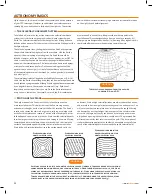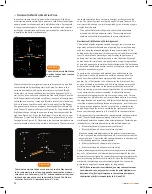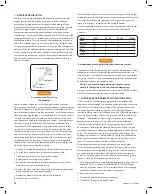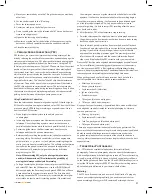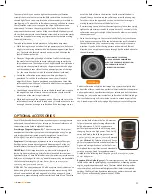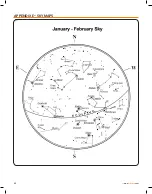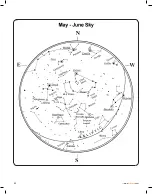
>>
www
.celestron
.com
31
To accomplish this, you need to tighten the secondary collimation
screw(s) that move the star across the field toward the direction of the
skewed light . These screws are located on the secondary mirror holder
(see figure 9-1). To access the collimation screws you will need to remove
the collimation screw cover to expose the three collimation screws
underneath. To remove the cover, place the tip of a flat screwdriver
underneath the cover and twist until the cover lifts off. Make only small
1/6 to 1/8 adjustments to the collimation screws and re-center the star by
moving the scope before making any improvements or before making
further adjustments.
To make collimation a simple procedure, follow these easy steps:
1 . While looking through a medium to high power eyepiece, de-focus a
bright star until a ring pattern with a dark shadow appears (see figure
9-2) . Center the de-focused star and notice in which direction the
central shadow is skewed .
2. Place your finger along the edge of the front cell of the telescope
(be careful not to touch the corrector plate), pointing towards the
collimation screws. The shadow of your finger should be visible when
looking into the eyepiece. Rotate your finger around the tube edge
until its shadow is seen closest to the narrowest portion of the rings
(i .e ., the same direction in which the central shadow is skewed) .
3. Locate the collimation screw closest to where your finger is
positioned . This will be the collimation screw you will need to
adjust first. (If your finger is positioned exactly between two of the
collimation screws, then you will need to adjust the screw opposite
where your finger is located).
4 . Use the hand control buttons to move the de-focused star image to
the edge of the field of view in the same direction that the central
obstruction of the star image is skewed .
5 . While looking through the eyepiece, use an Allen wrench to turn the
collimation screw you located in step 2 and 3 . Usually a tenth of a turn
is enough to notice a change in collimation. If the star image moves
out of the field of view in the direction that the central shadow is
skewed, than you are turning the collimation screw the wrong way .
Turn the screw in the opposite direction, so that the star image is
moving towards the center of the field of view.
6. If while turning you notice that the screws get very loose, then simply
tighten the other two screws by the same amount . Conversely, if the
collimation screw gets too tight, then loosen the other two screws by
the same amount .
7. Once the star image is in the center of the field of view, check to see
if the rings are concentric. If the central obstruction is still skewed in
the same direction, then continue turning the screw(s) in the same
direction. If you find that the ring pattern is skewed in a different
direction, than simply repeat steps 2 through 6 as described above for
the new direction .
FIGURE 9-3
A collimated telescope
should appear symmetrical
with the central obstruction
centered in the star’s
diffraction pattern.
Perfect collimation will yield a star image very symmetrical just inside
and outside of focus. In addition, perfect collimation delivers the optimal
optical performance specifications that your telescope is built to achieve.
If seeing (i.e., air steadiness) is turbulent, collimation is difficult to judge.
Wait until a better night if it is turbulent or aim to a steadier part of the
sky. A steadier part of the sky is judged by steady versus twinkling stars.
OPTIONAL ACCESSORIES
You will find that additional accessories enhance your viewing pleasure
and expand the usefulness of your telescope. For ease of reference, all
the accessories are listed in alphabetical order .
Erect Image Diagonal (#94112-A) – This accessory is an Amici prism
arrangement that allows you to look into the telescope at a 45° angle
with images that are oriented properly (upright and correct from
left-to-right). It is useful for daytime, terrestrial viewing.
Eyepieces – Like telescopes, eyepieces come in a variety of designs .
Each design has its own advantages and disadvantages. For the 1.25”
barrel diameter there are four different eyepiece designs available.
OMNI Plössl – Plössl eyepieces have a 4-element lens designed for
low-to-high power observing . All are fully multi-coated for maximum
light transmission. These Plössls offer razor sharp views across the entire
field, even at the edges! In the 1.25” barrel diameter, they are available in
the following focal lengths: 3.6 mm, 6 mm, 8 mm, 10 mm, 13 mm,
17 mm, 25 mm, 32 mm and 40 mm.
X-CEL LX – The newly enhanced X-Cel LX eyepiece series is what you’ve
been waiting for in a high quality eyepiece for planetary viewing . With
a brand new sleek and robust design and a twist-up eye guard, these
eyepieces are especially designed for comfort and ease of use . They also
have a wide field of view of 60° and 6-element
fully multi-coated optics for magnificent wide
field performance. X-Cel LX eyepieces are
parfocal and require little to no focusing when
changing from low to high power . The X-Cel LX
series is offered in the following seven sizes:
2.3 mm, 5 mm, 7 mm, 9 mm, 12 mm, 18 mm and
25 mm . Ultima LX – Celestron Ultima LX Series
parfocal eyepieces feature wide fields of view for
high and low magnifications. 70 º field of view
for high and low magnifications and extendable
twist-up eyecups - Good for eyeglass wearers .
Available in the following focal lengths: 5 mm, 8 mm, 13 mm, 17 mm,
22 mm and 32 mm .
Eyepiece, Micro Guide (#94171) – This multipurpose 12 .5 mm illuminated
reticle can be used for guiding deep-sky astrophotos, measuring position
angles, angular separations and more . The laser etched reticle provides
razor sharp lines, and the variable brightness illuminator is completely
cordless . The Micro Guide Eyepiece produces 224 power when used with
the CPC 1100 at f/10 and 163 power with the CPC 800.
Summary of Contents for 11007
Page 1: ...InstructionManual 11007 11008 11009...
Page 2: ...www celestron com...
Page 40: ...38 www celestron com APPENDIXD MAPSOFTIMEZONES...
Page 41: ...www celestron com 39...
Page 42: ...40 www celestron com APPENDIXE SKYMAPS...
Page 43: ...www celestron com 41...
Page 44: ...42 www celestron com...
Page 45: ...www celestron com 43...
Page 46: ...44 www celestron com...
Page 47: ...www celestron com 45...




